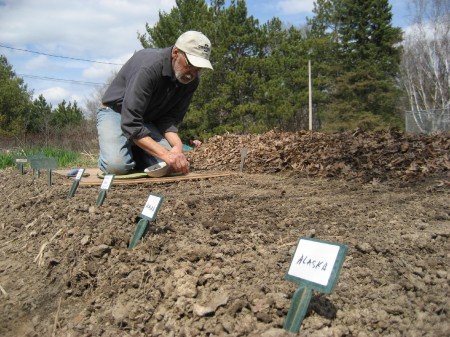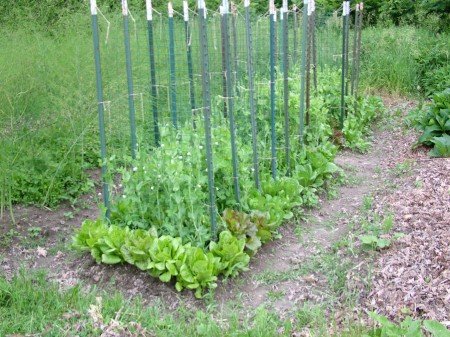Here’s me, yesterday, atop a bed, planting peas. We had a nice little break in the rainy weather, so I took the opportunity to get my peas seeded. I’m using a large piece of plywood to kneel on. The plywood disperses my weight and allows me to get right on top of the bed. It makes the work much easier that trying to reach in from the sides to set the peas in place.
The bed has just over 36″ of flat planting width across the top. I’m planting the peas 2 inches apart and planting a double row using back to back yardsticks as my guide. So I end up with a double row of peas with 19 peas in each row.
This year I’m spacing the rows 18 inches apart. Last year I used a 15″ spacing, which worked out fine, but I think the extra 3″ will allow a little more sun in and give me more room to plant lettuces and salad greens in between the peas. I did that last year with good success.
Once the peas begin to sprout, I’ll set up trellises using T-posts and 24″ fencing. Here’s a picture of last year’s peas showing the trellises in place and lettuces around and in between the peas.
I ended up with 13 double rows – roughly 494 peas. I planted six varieties, various snap and shell peas, capuciner soup peas (our favorite), and some snow peas. I’ve got the shorter sugar pea varieties planted in the south end and the tall capuciners and snow peas to the north. I don’t ever get 100% germination, although the home-saved capuciner peas sprout extremely vigorously, and I normally don’t have to thin the pea seedlings. This year I’ll be diligent about protecting them from woodchucks and other varmints. I’ve had some issues with critters when I did not get fencing up quickly enough. This year, with luck, we can expect a bountiful harvest not too many weeks away.


